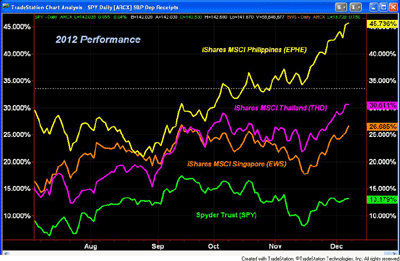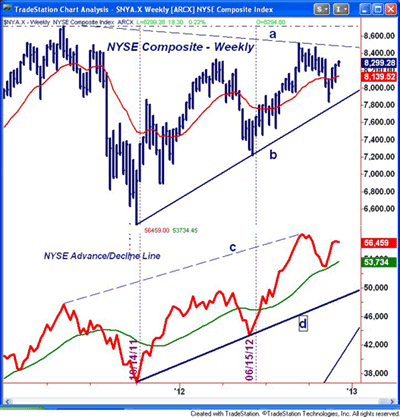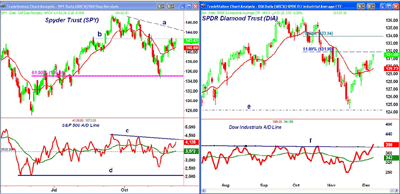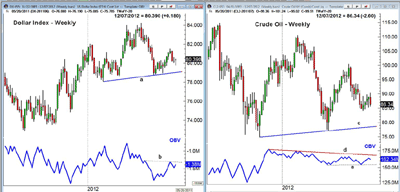Unusually mixed economic reports are stopping the US stock market from surging higher like many of the other global markets, but will this "wall of worry" be overcome? MoneyShow's Tom Aspray analyzes the data to determine whether you should be worried about the strength of the economy and which sectors you should watching for new investments.
The conflicting economic data last Friday made for further choppy trading, and the major averages closed mixed. The Dow Industrials and S&P 500 were higher, while the Nasdaq-100 closed the week lower.
It has been my view over the past few months that the stock market's strength was a sign that the economy was really stronger than the majority thought. Over the past few months, the economic data has been better than expected, with the housing sector especially strong.
From a global perspective, the industrial production has continued to be a concern, as it has turned negative for most of the world with the exception of the US and China. Therefore, last Monday's sharp drop in the ISM Manufacturing Index caught many off guard, as the consensus view was for a reading of 51.7 while the actual number was 49.5.
A value over 50 indicates an expanding manufacturing sector, so the November report did raise some concerns, as the chart shows a pattern of lower highs (line a) since early in 2011.
This report was followed last Wednesday by the ISM Non-Manufacturing Index, which came in at 54.7, above the consensus of 53.6. It indicates that the non-manufacturing economy is generally expanding. The chart on the right shows a gradual rise from last May's lows, but also shows a pattern of lower highs (line b).
The economic outlook was clouded further Friday when the monthly jobless report was much stronger than anticipated, while the preliminary University of Michigan consumer sentiment plunged to 74.5 from last month's 82.7. This suggests that the concerns over the fiscal cliff are making consumers more pessimistic.
So what does this mean for the stock market? Since early in November, overseas markets have been acting better and looking stronger than the US market. The major US averages need a burst of upside momentum and a close above the Election Day highs to signal the market is trending higher.
While the US markets have failed to break out, the markets in Asia are continuing to look very strong. For the year, the iShares MSCI Philippines ETF (EPHE) is up well over 45%, followed by a 30%-plus gain in the iShares MSCI Thailand (THD) and over 26% by the iShares Singapore (EWS). All three have more than doubled the 13% gain of the Spyder Trust (SPY).
The charts of many of the European ETFs have completed their three-month corrections and appear to be resuming their uptrends. Some are overbought short term, and could pull back this week before they again move higher.
The action of the global markets and the apparent bottom for the Chinese economy are likely to translate into higher US stock prices. It may take until early 2013 for the US market to catch up with stronger trends in the global markets, but I think the economy will come out fine.
This week, we have the FOMC meeting and its announcement Wednesday afternoon. This may be an important meeting ,as Operation Twist is set to end at the end of the year. Of course, the question is whether they will decide to do additional buying in 2013 in addition to the mortgage-backed securities. An aggressive new effort could help reverse the weakness in the metals.
Also on Wednesday, we get import and export prices, followed on Thursday by jobless claims, retail sales, the Producer Price Index and Business Inventories. Then on Friday, we get the Consumer Price Index and Industrial Production.
Also on Thursday and Friday, the European Council holds one of its meetings, as it does every six months. The announcement after their last meeting in June caused many of the markets to move sharply.
NEXT: What to Watch
|pagebreak|What to Watch
Though stocks held up pretty well last
week, the major averages needed a strong close to suggest we could see a further
rally this week. Instead, many of the market averages tested the highs from the
start of the week but were not able to exceed them. The Dow Industrials were the
exception.
Precious metals had a second day of heavy selling last week, which weakened the short-term outlook. So far, the early November lows are holding, but I did recommend taking some profits last week to reduce the exposure on the long side. I am still bullish for the intermediate term, and if the technical outlook improves, I am likely to get back in.
Two markets that look interesting are the dollar and crude oil. The yearly closes in both could provide us with some interesting insight for 2013, as the yearly ranges are often important. I will discuss them both in more detail later.
The big change in sentiment last week came from the financial newsletter writers, who became more bullish: they're now 43.6% bullish, up from 39.3% the previous week. The individual investors have also become more positive after a big jump the previous week. Now 42% are bullish, as opposed to a low reading of 28.6% on October 18.
The close this week is likely to be important, as are the market internals. The weekly chart of the NYSE Composite shows the higher closes over the past three weeks as the resistance in the 8,250 to 8,300 area has been reached. There is further resistance at 8,400 with the weekly downtrend (line a) at 8,488.
The weekly NYSE Advance/Decline line has continued to make higher highs since 2009 (line c), which is bullish for the intermediate trend. The A/D line bounced from the rising 21-week WMA four weeks ago, but was flat last week. A lower close and negative A/D ratio this week will cause it to turn lower. This would be consistent with further consolidation.
A drop in the A/D line below the WMA and the previous low would be more negative and suggest a test of the uptrend (line d). There is initial support now at 8,225, with the 20-week EMA following at 8,139. The weekly uptrend (line b) is at 7,826.
S&P 500
The rally in the Spyder
Trust (SPY)came
very close to the 61.8% resistance at $143.02, as the week's high was $142.92.
The chart shows that this is an area of significant chart resistance (line b).
The downtrend from the October highs (line e) is now at $144.66.
The S&P 500 A/D line shows a pattern of higher highs, but the uptrend has not been that strong. It still needs to move convincingly above the resistance (line c) and the past two highs to signal upward acceleration. There is first support at the November lows, and then more important at line d.
The slightly rising 20-day EMA is at $140.96, with further support at $140.37, which was last week's lows. If it is broken, there is stronger support in the $138 to $138.50 area.
Dow Industrials
The SPDR Diamond Trust
(DIA)rallied
more sharply last Friday, as it made new highs for the week. The 61.8% Fibonacci
retracement resistance is at $131.90, with the 78.6% level at $133.94. The
selling in the dividend stocks hit DIA hard in November, as it dropped 8.8% from
its highs.
The Dow Industrial A/D line has also improved, as it is just above the key resistance (line f). There is first good support for DIA now at $130 to $130.50, and then in the $129 area.
NEXT: More Stocks, Sector Focus, and Tom's Outlook
|pagebreak|Russell 2000
The iShares Russell 2000
Index (IWM)
also made its high last Monday, reaching $82.76, which was just below
the 61.8% Fibonacci retracement resistance at $82.83. The next resistance from
October is at $84.15, and a close above this level will be important.
The Russell 200 A/D line is above its rising WMA, but still below the long-term resistance.
The daily chart has first support at $81.40, which was last week's low, with stronger levels around $79.50 to $80.50.
Nasdaq-100
The PowerShares QQQ Trust
(QQQ)
peaked last Monday at $66.37,which was just above the 50% retracement
resistance at $65.93. The 61.8% Fibonacci retracement resistance is at $67.05.
The weekly chart shows that after two consecutive higher weekly close, last
week's close was lower.
The relative performance or RS analysis broke its uptrend (line b) in early October, as it was already below its WMA. It turned down again last week, and shows a pattern of lower highs and lower lows.
The weekly on-balance volume (OBV) violated its WMA on October 13, but is still holding above the next important support (line c). It did confirm the September highs.
The Nasdaq-100 A/D line (not shown) was not strong last week, and has turned lower.
QQQ closed just above the monthly pivot support at $64.44, with the 50% retracement support at $63.85. Prices came close to the weekly Starc- band in the middle of November, and the support in the $60 area (line a) is quite important.
Sector Focus
The iShares Dow Jones
Transportation (IYT)
closed last week barely higher, but is still badly lagging the Dow Industrials.
This divergence
between the two Dow averages, which became more pronounced in September,
continues to act as a negative factor for the market.
Using the pre-closing data, the week's best performer was the Select Sector SPDR Financial (XLF), which gained 1.5% for the week. The Select Sector SPDR Materials (XLB) was the big loser, as it lost 1.9%. It was hurt by the sharp drop in Freeport McMoran Copper & Gold (FCX), which dropped over 18%. It is an 8% holding in XLB.
The Select Sector SPDR Industrials (XLI) was just up 0.8% for the week, but this was enough to turn the weekly studies positive. There is major weekly resistance now at $38.07 to $38.17 (line d), and an upside breakout would be very bullish.
The relative performance broke its weekly downtrend (line f) at the end of October, and has now clearly started a new uptrend. This signals that is now outperforming the S&P 500. The weekly OBV will close the week back above its WMA, which is also a positive sign.
There is first support now at $36.60 and then in the $35.70 to $36 area. As for stops on new longs, they will need to be under the mid-November low of $35.19-more later this week.
NEXT: Dollar, Commodities, and Tom's Outlook
|pagebreak|Dollar Index
The dollar index closed last week a bit
higher, and there is lots of debate about this chart. The dollar bears paint it
as a head-and-shoulders top with the neckline at line a.
The longer term picture to me is not that bearish, as the OBV shows a bullish zig-zag formation. A move above the OBV resistance (line b) would be positive. When the dollar moves up, gold often moves down so stay tuned.
Crude Oil
The weekly chart of crude oil shows that prices
have been trying to stabilize in the $84 to $86.50 area, but it did close the
week lower.
The OBV is acting stronger than prices, but still many are looking for sharply lower crude oil prices. If so, the OBV is likely to break below support (line e) ahead of prices. Crude oil prices are likely to close the year lower for the first time in three years.
Precious Metals
Both the Spyder Gold Trust
(GLD)
and the iShares Silver Trust (SLV)
closed the week a bit lower, but well above the worst levels. The daily charts
suggest two possible scenarios for the metals, as I discussed last week in Two
Paths for Precious Metals.
I recommended closing out part of the long positions last week, and they were sold a bit lower than where we closed the week.
The Week Ahead
Even though stocks were not that strong
last week, the market was quite resilient, as the dips have been brief. The
S&P futures tested support at 1,396 early Wednesday, but then rallied to
close higher and settled the week at 1,416.50.
There were not many good risk entries last week, so it was more difficult to be a smart buyer by buying at more important support. I believe there will be some opportunities in the next week or so.
Some of the strong country ETFs are likely to correct back to support, which should provide another opportunity to buy. I also will be looking at the industrial sector, as the weekly relative performance looks very strong.
An alternative to individual stocks might be the equity income funds that I discussed last week, as they are still well below their September highs. Since stocks did move higher this week, be sure to check your own positions to see if your stops need to be modified. I raised some of the stops in the Charts in Play Portfolio last Friday.
- Don't forget to read Tom's latest Trading Lesson, Managing Risk & Protecting Profits

















